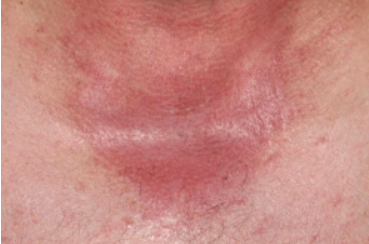Drug-induced photoallergic reaction is an allergic reaction that occurs in the skin when sunlight or ultraviolet radiation interacts with a drug or chemical substance that has photosensitizing properties. ICD-10 code: L56.1
Photoallergic reactions develop in sensitized individuals upon repeated interaction of a photosensitizing drug or chemical substance with sunlight or ultraviolet radiation. Drugs, chemicals, or their metabolites, upon absorption of light photons, form photoactive compounds in the skin that acquire immunogenic properties and initiate delayed-type hypersensitivity immune responses.
Photoallergic reactions occur in individuals of all races, regardless of sex, and are more common in adults than in children. They typically develop under the influence of long-wave ultraviolet radiation (UVA), and less commonly under medium-wave ultraviolet radiation (UVB) or visible light.
The following medications and chemical substances most commonly trigger photoallergic reactions:
- Systemic drugs effects causing photoallergic reactions: antiarrhythmic drugs (quinidine), phenothiazines, quinolones, non-steroidal anti-inflammatory drugs (ketoprofen, piroxicam), antifungal agents (griseofulvin, itraconazole), nalidixic acid, sulfonamide drugs, quinine.
- Topical medications and chemical compounds causing photoallergic reactions: ingredients in sunscreens (benzophenones, derivatives of para-aminobenzoic acid), fragrances, non-steroidal anti-inflammatory drugs (ketoprofen, meloxicam, piroxicam), phenothiazines, salicylates, chlorhexidine, hexachlorophene, triclosan. Photoallergic reactions are more commonly developed with the use of topical medications.
The diagnosis is based on the patient's history (report of use of any medication or chemical substance followed by sun exposure or artificial ultraviolet light exposure, appearance of eruptions on exposed skin areas), clinical presentation, results of phototesting, and laboratory tests.
Laboratory Tests:
- Complete blood count, urinalysis and blood biochemistry;
- Blood level autoantibodies: antinuclear factor, antibodies to double-stranded (native) DNA, Sm, Ro/SS-A and La/SS-B antigens, etc. (performed to rule out systemic lupus erythematosus);
- Porphyrin levels in blood plasma, erythrocytes, and urine (performed to rule out porphyria).
- Sunburn
- Irritant contact dermatitis
- Allergic contact dermatitis
- Eczema
- Systemic lupus erythematosus
- Porphyria cutanea tarda
Treatment Objectives
- Resolution of skin eruptions;
- Alleviation of negative subjective sensations; prevention of new eruptions;
- Improvement in the quality of life of patients.
General treatment features:
- The primary focus of treatment is to eliminate exposure to the drug or chemical that caused the adverse effect and to limit exposure to sunlight (ultraviolet). If complete discontinuation of the medication is not possible, it is recommended that the medication be taken in the evening to reduce the concentration of the drug in the skin during daylight hours. Patients should avoid sun exposure, especially during the most active hours of sunlight. Regular use of sunscreen and wearing clothing and hats are recommended.
- It should be noted that in some cases increased photosensitivity may persist for several weeks or months after discontinuation of the photosensitizing medication.
- Symptomatic therapy is used to treat eruptions. If blisters are present, they are opened. Cold compresses or moist, drying dressings are applied to areas of erythema and skin swelling.
- Use of moisturizers and topical glucocorticosteroids is recommended, although evidence of their efficacy is lacking. For acute inflammatory manifestations, glucocorticosteroids are prescribed in form of emulsions, lotions, or creams.
- In some cases, antihistamines or analgesics may be recommended.
- For severe reactions, systemic glucocorticosteroids are used.
Systemic Therapy
Antihistamines
- Loratadine 5-10 mg orally once daily for 7-10 days or
- Cetirizine 5-10 mg orally once daily for 7-10 days or
- Ebastine 5-20 mg orally once daily for 7-10 days or
- Levocetirizine 5 mg orally once daily for 7-10 days.
- Prednisone 60-80 mg per day orally for several days, followed by gradual tapering of the dose until complete discontinuation.
Topical Therapy
Topical Glucocorticosteroids
- Mometasone furoate topically 1-2 times a day or
- Methylprednisolone aceponate topically 1-2 times a day or
- Alclometasone dipropionate topically 1-2 times a day or
- Betamethasone valerate topically 1-2 times a day or
- Betamethasone dipropionate topically 1-2 times a day or
- Fluticasone propionate topically 1-2 times a day or
- Hydrocortisone butyrate topically 1-2 times a day or
- Clobetasol propionate topically 1-2 times a day.
Course: 2-4 weeks.
If topical therapy does not have the desired effect, systemic glucocorticosteroids are prescribed.
Prevention
- Patients should avoid the use of medications and chemicals that induce photoallergic reactions.
- If discontinuation of medication is not possible, patients should minimize their exposure to the sun, protect their skin from sunlight with clothing and SPF.
- Patients should be informed about the ability of UVA ultraviolet radiation to penetrate window glass.

